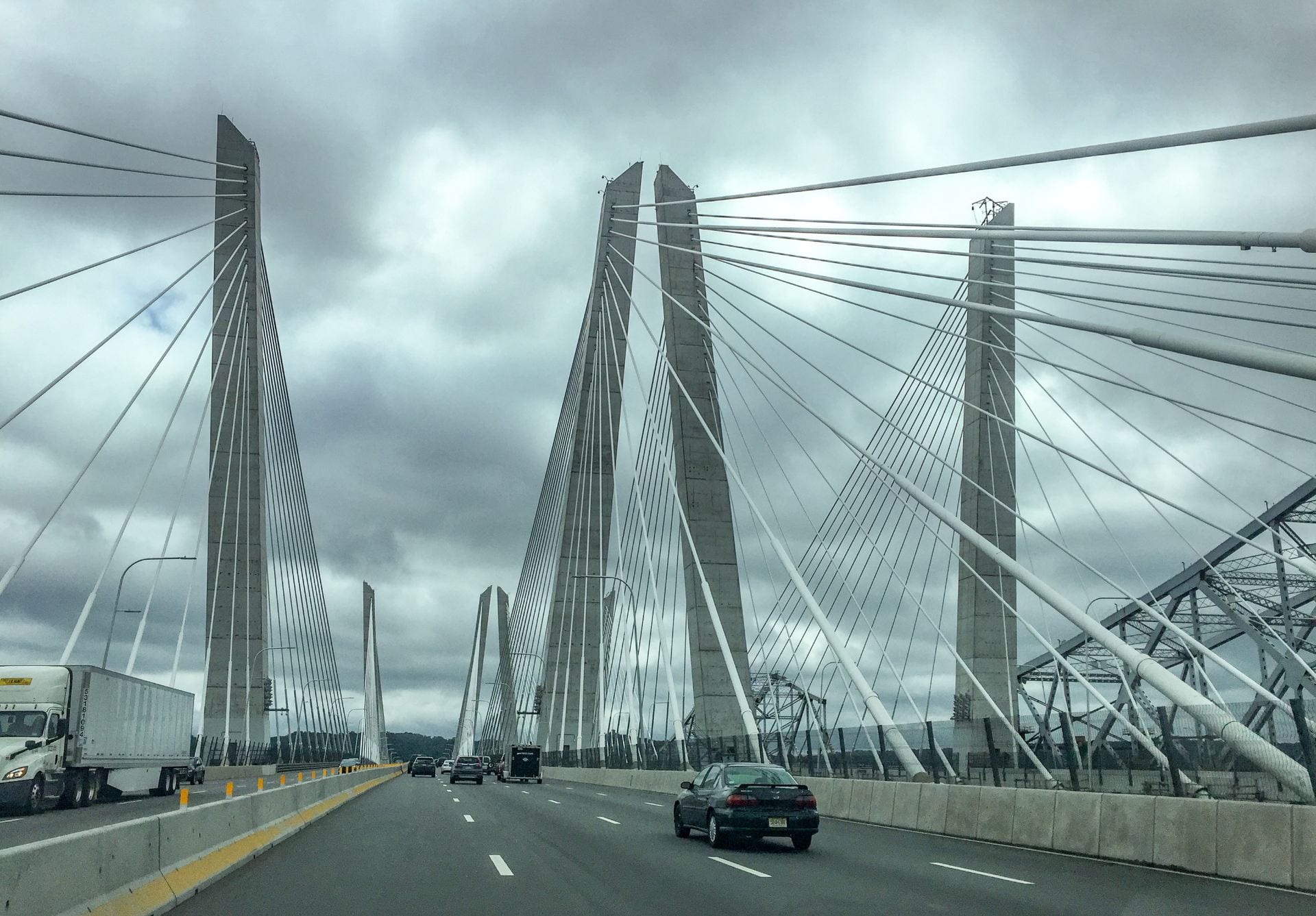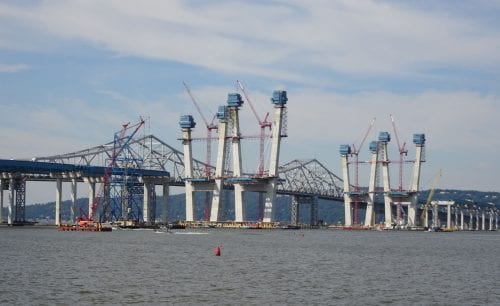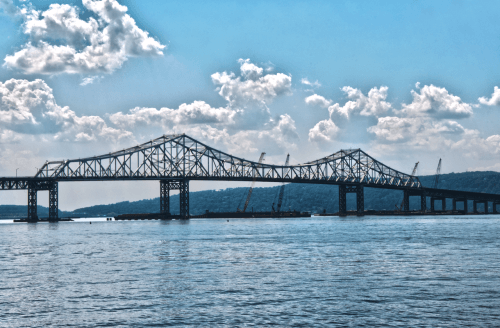
Public infrastructure has long been financed through direct government budgetary appropriation, grants, and government borrowing. The long-term debts have typically been repaid from revenues generated by the asset through user charges, or from the general taxing power of the government. With an increasingly high demand for infrastructure investments, and limited resources to achieve them, other means of financing must be explored. One way to approach financing infrastructure is to monetize gains accruing to landowners. While challenges to such land-based financing are many, there is a sound argument for tapping the gains capitalized in property and land values (Huston & Lahbash, 2018). This post will discuss the case of the recently rebuilt Tappan Zee Bridge and explore land-based financing as a means to “bridge the gap”.
The Governor Mario M. Cuomo Bridge was opened for use in 2017 replacing the aging Tappan Zee Bridge, which was operating well beyond its designed life span and capacity. The earlier bridge was a poster child for crumbling infrastructure in the United States, and its replacement was undoubtedly a necessary move. There were six options being considered for the design of the bridge, including one that incorporated commuter rail crossings for use by the Metropolitan Transportation Authority. The one that was eventually selected was a twin cable-stayed bridge with 8 lanes of dedicated traffic, plus emergency and future express bus lanes (HDR Inc., n.d.). The bridge includes a shared-use path for bicycles and pedestrians and features All-Electronic Toll Collection (AETC) systems.

The final costs for the new bridge were a shade under $4 billion that was funded by a $1.6 billion TIFIA[1] loan from the USDOT, $1.28 billion from bond proceeds, and the rest from State Thruway Authority pay-as-you-go contributions, primarily from the Thruway Stabilization Fund. The TIFIA program provides flexibility in the payback period, allowing borrowers to defer repayment up to five years after completion of the project. In this case, the program will save the Thruway Authority around $350 million over 35 years when compared with other debt options (Citizens Budget Commission, 2017).
There have been numerous debates on how the loans and bonds will be repaid. While the state government is subsidizing a freeze on the toll until 2020, the deliberations continue, and a newly formed commission will be required to make a decision before then. It is estimated that the annual debt service costs will be around $174 million, which is about 24% in excess of what the Thruway Authority can currently afford while maintaining its required coverage ratios of 1.5 for senior debt and 1.35 for junior debt from TIFIA. To bear the difference, the Thruway Authority must increase its revenues to stay current on its obligations. Being an agency supported by tolls, having direct users bear the increased costs is the most straightforward financial solution, and a toll increase in widely expected from 2020 (Spector, 2019).
Of the many proposed solutions, there are two big ones. First, a blanket increase of tolls on the entire Thruway system by 24%. While this would affect users who may not even use the bridge, its proponents cite the need of the system to act as one – the bridge being simply one cog in the entire machine for access to the Northeast region and the Port of New York and New Jersey. Second, another camp suggests a push for doubling the tolls on the bridge itself (Reakes, 2017). The doubling may sound drastic, but it would bring the tolls in line with the Port Authority’s rates on the George Washington Bridge just 25 miles away. Studies indicate that the demand on the bridge is fairly inelastic, providing an opportunity for an increase without loss in traffic (New York Thruway Authority, 2012).

Although both arguments have their merits, can the bridge be imagined as part of a complete transportation system, and not one just of the Thruway Authority jurisdiction? More importantly, if transportation and land-use are directly linked, and costs must be borne by all beneficiaries, must we not consider the immense land-use benefits afforded by speedy connectivity over the Hudson to the counties on both sides? After all, the siting of the bridge here, at one of the widest parts of the Hudson, was jurisdictionally political (Plotch, 2015). The bridge was situated just outside the jurisdiction of the Port Authority of New York & New Jersey, thereby allowing the revenues to accrue to the Thruway Authority.
While this may have been happenstance due to external factors, the properties in Westchester and Rockland counties are the direct beneficiaries of the bridge. The corridor served by the bridge will experience a 17% increase in population and a 33% increase in jobs over the next 30 years (New York Thruway Authority, 2012). While there has been no study of the impact to land value on either side of the bridge, a no-build scenario portrays significant cost to the communities due to diversions and delays on a system already at capacity. Should the repayment plan not include contributions from the direct benefits to land and its use? Whether by imposing a fractional amount of property taxes for a piece of the pie that is increasing in land values, or by a cess on sales due to the increased traffic, a value capture could provide a more equitable funding source. The benefit of such land-based financing is its applied proportionality to land values and land ownership and its balancing of windfalls for owners of specific land units whose values increase following public investment in infrastructure.
Whatever be the final model reached, whether through value capture, sales taxation, or even increased tolling, it should be done sooner rather than later, so that the costs are borne by the actual beneficiaries of the project rather than subsidized by the state.
—
[1] The Transportation Infrastructure Finance and Innovation Act (TIFIA) program provides credit assistance for qualified projects of regional and national significance. The TIFIA credit program is designed to fill market gaps and leverage substantial private co-investment by providing supplemental and subordinate capital (United States Department of Transportation, 2018)
—
References
Citizens Budget Commission. (2017). Bridging the Financial Gap: Funding the Governor Mario M. Cuomo Bridge. New York. Retrieved March 31, 2019, from https://cbcny.org/research/bridging-financial-gap
HDR Inc. (n.d.). Governor Mario M. Cuomo Bridge Design-Build. Retrieved April 2, 2019, from HDR Inc. Portfolio Website: https://www.hdrinc.com/portfolio/governor-mario-m-cuomo-bridge-design-build
Huston, S., & Lahbash, E. (2018). Land Value Capture and Tax Increment Financing: overview and considerations for sustainable urban investment. European Journal of Sustainable Development Research. doi:http://dx.doi.org/10.2139/ssrn.3103949
New York Thruway Authority. (2012). TIFIA Application for Tappan Zee Hudson River Crossing Project. Retrieved April 1, 2019, from https://www.newnybridge.com/documents/study-documents/tifia-sept-2012.pdf
Plotch, P. M. (2015). Politics Across the Hudson: The Tappan Zee Megaproject. New Brunswick: Rutgers University Press.
Reakes, K. (2017, October 17). Estimate Made For 2020 Toll Hike On New Tappan Zee Bridge. Clarkstown Daily Voice. Retrieved March 30, 2019, from https://dailyvoice.com/new-york/clarkstown/business/estimate-made-for-2020-toll-hike-on-new-tappan-zee-bridge/724103/
Spector, J. (2019, January 15). What about Mario Cuomo Bridge tolls? Cuomo talks what’s next after Tappan Zee demolition. Lohud. Retrieved March 31, 2019, from https://www.lohud.com/story/news/politics/politics-on-the-hudson/2019/01/15/mario-cuomo-bridge-tolls/2580921002/
United States Department of Transportation. (2018, June 27). Overview: Build America Bureau. Retrieved April 1, 2019, from USDOT: Build America Bureau Website: https://www.transportation.gov/buildamerica/programs-services/tifia/overview
